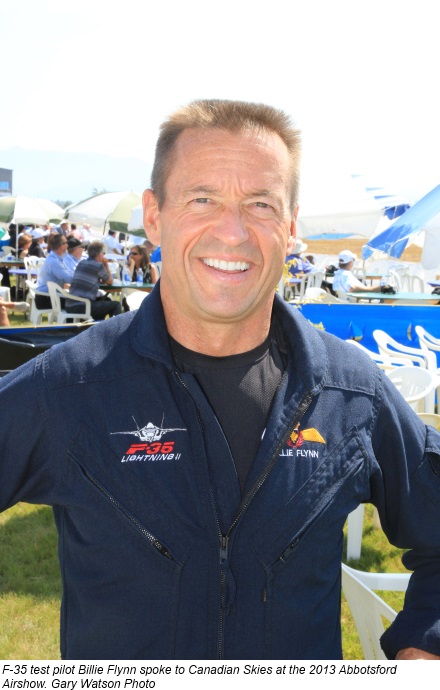Estimated reading time 3 minutes, 44 seconds.

There’s no doubt that Canadian test pilot Billie Flynn is a believer in the Lockheed Martin F-35 Lightning II. A former RCAF 441 Squadron commanding officer during the UN-led Kosovo bombing campaign in 1999, Flynn has real-time combat experience in the Boeing CF-18 Hornet. Since retiring from the RCAF, Flynn has been a contract test pilot, flying most new generation fighters – including the Dassault Rafale, Eurofighter Typhoon, and Lockheed Martin F-16 Fighting Falcon – before landing the high profile job as a contract test pilot for all three variants of the F-35. He stopped adding up his flying time years ago, but has accumulated more than 5,000 hours flying in 70 different aircraft types. At age 55, Flynn intends on flying for a further 10 years.
“The F-35 is the best aircraft I have ever flown,” he told Canadian Skies in an interview during the 2013 Abbotsford Airshow. “It is easy to fly with the flight computers; but, more importantly, the sensor fusion along with the ‘Iron Man’ helmet and display provide a level of awareness not possible in any other aircraft. The test pilot cadre at Lockheed Martin have flown every fighter aircraft in existence, and all are firm fans of the F-35.”
Flynn is responsible for expanding the flight envelope of all three variants. “I haven’t had any major surprises. The actual aircraft is so close to the simulators that I haven’t found any major issues. The aircraft is really easy to fly and the helmet display is incredible. The F135 engine was developed from the F-22’s F119 engine and has been extremely reliable with no G-limits. The STOVL (Short Take Off Vertical Landing) hovering in the B model is very stable, as expected, and easy, compared to the same maneuver in the Harrier.”
The possibility of information overload with the new helmet and sensor technology has been greatly reduced by what Flynn calls “sensor fusion,” where only information that is immediately required by the pilot is displayed. “If you take away everything you have to monitor and just leave the tactical information, the pilot workload can be totally focused on the immediate task.”
F-35 fatigue testing has passed the initial 8,000 hour fatigue life on both the A and B models, with second life extension testing now underway. The expectation is for 90 per cent of the fleet to achieve the full life of 8,000 hours.
The fighter program is well underway, with 100 aircraft flying and eight delivered to the U.S. Marine Corps at its principal F-35 unit at USMC Yuma, Ariz. New combat tactics are now being developed to take advantage of the stealth and sensor capabilities of the aircraft.
A year ago, Lockheed Martin had built about 40 aircraft and had a dozen or so pilots flying them. Today, there are more than 100 aircraft and 100 pilots involved, consisting of 43 U.S. Air Force pilots, 33 U.S. Marines pilots, five U.S. Navy pilots, four pilots from the United Kingdom, and 15 Lockheed Martin contract pilots. Before flying this advanced jet, pilots must complete 97 training courses, consisting of a mixture of computer and simulator time, plus seven flights. Once the initial course is completed and passed, the pilot graduates to operational flying training.








